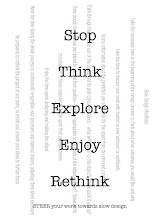Slow processes and what Slow means to me: A partially finished series of ideas
In my opinion Slow is a thought process or philosophy rather than a time reference – just because a task takes a long time does not mean it is a Slow task. I feel that Slow can be defined as taking appropriate time compared to our perceived normal 21st century way of living (seen as Fast). A Slow process to me is one that has been well considered and thus decided upon due to its appropriateness. This consideration may only need to be undertaken once as the resulting information could be held in mind for future projects, or it may be that the thinking needs to be done every time a process is used. Slow and working in a Slow manner is about appropriateness, in terms of material choices, process choices and intended outcomes of your processes; in this sense Slow relates to time because, by working within a Slow framework one allows oneself the time to consider the available options, regardless of the scale of operation.
I feel that the following things should be considered as part of a Slow working process:
What is the intended outcome of the process?
What is the intended outcome for the series of processes, what are you intending to make?
What impact does the process have environmentally, both small and large scale, and if negative, how could this be reduced?
Also post-consumer use and recycling of the end product.
This should lead to a list of ‘needs’ for the outcome, which should help determine which process is most appropriate. I believe that Slow relates to processes in a decision making format – why use that process? Is it the most appropriate for the intended outcome of the process?
I feel that one does not need to be personally involved in the process itself to consider it and its implications, also I feel that processes can be considered on an industrial scale. One does not need to be an individual designer maker to work within a Slow framework/context, nor does one need to be a professional designer.
Personally when deciding upon a process I use my STEER theory, developed to offer a framework for Slow design. I take a few moments to consider what I need it to do (STOP), I then consider whether it will do that to the standard I need it to, be that finished perfection or experimental designing stages (THINK), I then might ask around or look online to see if there is any other way of doing it – is there a way better environmentally or more appropriate aesthetically (EXPLORE). I then go ahead with the process I have decided upon and involve myself in my making process (ENJOY). I will at some point look over what I have done and how I did it in order to establish if I was happy with it, practically, environmentally and aesthetically and how I would do it if I were to repeat that process (RETHINK). Part of working Slowly is being willing to rethink, revisit ideas to rework them. Particularly as someone who is concerned about the environmental impact of my work I find the ‘re-‘ stages of my work very interesting, and often they offer a lot to learn from.
THOUGHTS:
‘The moral significance of work that grapples with material things may lie in the simple fact that such things lie outside the self’ (
Crawford, M; Shop Classs as Soulcraft; 2009; p16)
‘…severing of the cognitive aspects of manual work from its physical execution’
(
Crawford, M; Shop Class as Soulcraft; Penguin 2009; p31) – I think Slow can help reconnect the two.
‘As to the hope of the product, I have said that Nature compels us to work for that. It remains for us to look to it that we do really produce something an not nothing…’ (
Morris, W; Useful Work Versus Useless Toil; Penguin 2008; p3)
‘We shall not, therefore, be concerning ourselves with objects as defined by their functions or by the categories into which they might be subdivided for analytic purposes, but instead with the processes whereby people relate to them and with the systems of human behaviour and relationships that result therefrom.’ (
Baudrillard, J; The System of Objects; Verso 2005; p2)
